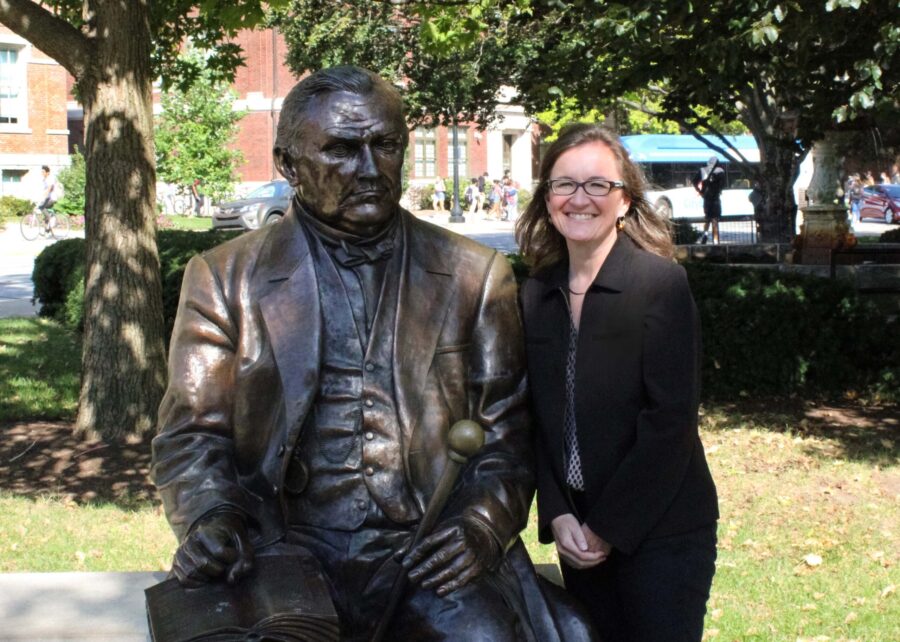Nutrition Science department head reveals family ties to Purdue’s founding father
Written By: Rebecca Hoffa, rhoffa@purdue.edu

Laura Murray-Kolb stands next to the statue of her third great-granduncle, John Purdue. Kolb passes by the statue each day on her way to her office in Stone Hall.Rebecca Hoffa
As Laura Murray-Kolb, professor and department head in the Department of Nutrition Science, began her new role in the Purdue University College of Health and Human Sciences (HHS) and brandished her gold and black for the first time, it wasn’t just the Boilermaker spirit she was feeling. Rather, she felt a renewed sense of connection to her family, as she admired the work of her third great-granduncle and the University’s founder, John Purdue.
Murray-Kolb has known her family history since she was little. She remembers reading a line from her great-grandmother’s autobiography that mentions her father’s uncle John giving money to start Purdue University. However, it wasn’t her family connection that led her to Purdue — in fact, she kept it secret until after she had accepted the position and arrived on campus. Murray-Kolb was drawn to the University’s reputation, its land-grant mission and the abundance of collaborative opportunities on campus. Before arriving, the connection to John Purdue was just a fun piece of family history.
“It feels very different now that I’m here,” Murray-Kolb said. “There’s a heightened interest in him as a person. Obviously I know he gave this money, but I just wonder: What kind of man was he, and what was he thinking when he gave it? What was he envisioning?”
Since arriving in West Lafayette, Murray-Kolb and her husband have been reading up on John Purdue and the contributions he made not only to Purdue but to the entire Greater Lafayette community. One thing she noted was an anecdote about John Purdue taking notes on anything he had nearby, whether it was an envelope or another scrap.
“My husband started laughing because I will write notes on napkins and anything like that, and he said, ‘I don’t know if this is a genetic connection, but isn’t that funny that you have that in common?’” Murray-Kolb chuckled. “I definitely have napkins and envelopes stuck in my lab notebook. I will use anything to write something down.”
In addition to their shared note-taking habits, Murray-Kolb has the same passion as her ancestor for Purdue’s land-grant mission to provide affordable, quality education to all and to translate the University’s knowledge and research back to the community. She hopes to continue John Purdue’s vision in her role as head of the Department of Nutrition Science.
“It seems to me that he would have been really interested in making sure that education was accessible to individuals, and that’s something I really want to make sure we continue in our department — that we reach out, that we are inclusive,” Murray-Kolb said. “I think he would have said these opportunities should be open to anybody who is eligible, and we should help them get there. That’s something that I definitely hope Nutrition Science will be known for and continue to be known for.”
While Murray-Kolb knows she has a lot more to see of Purdue’s traditions, she admires the beauty and history in the brick buildings, the Bell Tower and most of all, the statue of John Purdue in Memorial Mall. As she passes by it each morning on her way to her office in Stone Hall, she mentally wishes good morning to “Uncle John.”
“As I walk by, I always think that I wish he could see what it has become,” Murray-Kolb said. “I don’t know what he had in mind when he gave the money back in the 1800s, but I just wonder if he knows what an amazing place it is and how many people’s lives it has touched — not just in Indiana but really all over the world. Whenever I pass the statue, I feel grateful for the money that he gave and his foresight into thinking about how we needed a university here.”
As she keeps walking, she is reminded of the legacy she personally carries, as a relative of the man who made the entire campus possible.
“I hope that I make him proud, and I hope that I carry on whatever vision and legacy he had when he gave the money and thought about the University to begin with,” Murray-Kolb said.